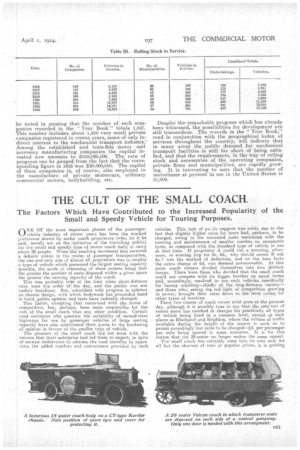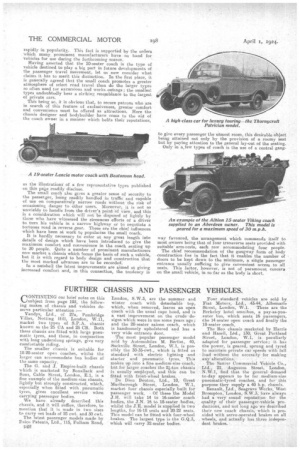THE CULT OF THE SMALL COACH.
Page 15

Page 16

If you've noticed an error in this article please click here to report it so we can fix it.
The Factors Which Have Contributed to the Increased Popularity of the Small and Speedy Vehicle for Touring Purposes.
COE OF the most important phases of the passengerV/ vehicle industry of ecent -ears has been the marked pieference shown by motlor coach proprietors (who, let it be said, merely act on the initiative of the travelling public) for the small and speedy type of motor coach built to carry about 20 people. When the coaching movement first.received a definite status in the Irealm of passenger transportation, the one and only aim of almost all proprietors was to employ is type of vehicle which possessed the largest seating capacity possible, the mode of refisoning of these owners being that the greater the number of seats disposed within a given space the greater the earning iiia,pacity of the coach.
This was probably true at the time when short-distance runs were the order of) the day, and the public was not unduly fastidious. But, coincident with progress in relation to chassis design, with which bodywork has proceeded hand in hand, public opinion and taste have radically changed.
This factor, excepting that concerned with the stress of competition, has, perhaps, been more responsible for the cult of the small coach than any other condition. Certain road surveyors who question the suitability of second-class highways for use by passenger vehicles of large seating capacity have also contributed their quota to the hardening of opinion in favour of the smaller type of vehicle.
The pioneers of the small coach did not meet with the success that their enterprise had led them to expect, in spite of earnest endeavours to educate the road traveller to appreciate the added comfort, and convenience provided by such
vehicles. This lack of pulilic support was solely due to the fact that slightly higher rates for tours had, .perforce, to be charged, owing to the increased costs associated with the running and maintenance of smaller coaches on pneumatic tyres, as compared with the standard type of vehicle in use at that time. If proprietor A could run a morning, afternoon, or evening trip for 3s.. 6c1., why should owner B ask 4s, ? was the method of deduction, and on the bare facts the extra charge of 6d. was deemed unreasonable. At this point coach owners divided themselves into two distinct camps. There *Were those who decided that the small coach could not compete with its bigger brother on equal terms and, accordingly, resolved to use such vehicles specifically for luxury coaching—chiefly of the long-distance variety— and those who, seeing ilia red light of competition growing in power, brought their rates down to the level ruling. for other types of machine.
These two classes of coach owner exist even at the present day, although it is possibly true to say that the rate-war of recent years has resulted in charges for practically all types of vehicle being fixed at a common level, except at such places as Blackpool and Brighton, where the volume of traffic available during the height of the season is • such as to permit exceedingly low rates to be charged—id. per passenger per, mile being quoted in some instances. It is for this reason that the 28-seater no longer makes the same appeal.
The'small coach has certainly come into its own and, for all but the shortest of runs at popular prices, it is gaining rapidly in popularity. This fact is supported by the orders which many prominent manufacturers have on hand for vehioles for Use during the forthcoming season.
Having asserted that the 20-seater coach is the type of vehicle destined to play e big part in future developments of the _passenger travel movement, let us now consider what claims it has to merit this distinction. In the first place, it is gelierally agreed that the small coach promotes a greater atmosphere of select road travel than do the larger types so often used ter excursions and works outings; the smallest types undoubtedly bear a striking resemblance to the largest of private cars.
This being so, it is obvious that, to secure patrons who are in search of this feature of exclusiveness, greater comfort and convenience mustbe offered as attractions. Here the chassis designer and bodybuilder have come to the aid of the coach .ownet in a manner which befits their reputations,
as the illustrations of a few representative types published on this page readily disclose. The small coach also pees a greater sense of security to the passenger, being readily handled in traffic and capable of use on comparatively narrow rciads without the risk of occasioning danger to other users. Moreover, it is not so unwieldy to handle from the driver's point of view, and this is a consideration which will not be disposed of lightly by those who have witnessed the strenuous efforts of a driver to turn his vehicle in a narrow highway or to negotiate a torture's road in reverse gear. These are the chief influences which have been at work te popularize the small coach. It is hardly necessary to enter at any great length into details of design which have been introduced to give the maximum comfort and convenience in the coach seating up to 20 people. Quite a number of prominent manufacturers now market a chassis which forms the basis of such a vehicle, but it is with regard to body design and construction that the most marked advances are to be recorded.
In a nutshell the latest improvements are aimed at giving increased comfort. and, in this connection, the tendency is way favoured, the arrangement which commends itself to most owners being that of four transverse seats provided with suitable arra-teste, each row accommodating four people. The chief recommendation of the gangway form of body construction lies in the fact that it enables the number of doors to be kept down to the minimum, a sitigle passenger entrance usually sufficing to give convenient access to all seats. This factor, however, is not of paramount concern on the small vehicle, in so far as the body is short,






















































